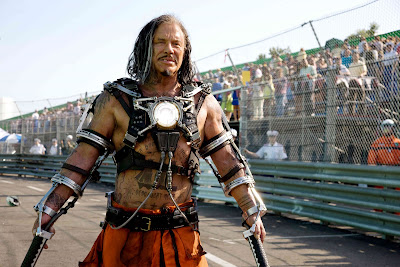.
Does Moffat’s first Christmas special have to be his version of A Christmas Carol? Really? Isn’t it enough that every other TV show ever has done that? Apparently not. Although, to be fair, at least he puts a spin on it that makes good use of the TARDIS and, for that matter, good use of The Doctor’s familiarity with the works of one C. Dickens (he told him he was a big fan a few years ago, you may recall).
So, for a pre-title sequence we have the good ship HMS MacGuffin plunging towards certain death in the atmosphere of a planet at Christmas – jingle any bells? Any sign of an Australian songstress? No, but there is a Welsh one in a fridge. More on that, later.
We have Amy and Rory doing a little role-play in the honeymoon suite and …. Well, that’s about it, really. They serve no dramatic purpose after that, so this was them basically turning up to smile and wave and give fourteen year-olds of all ages something to snigger about.
The story proper begins with a gorgeous FX of the city, dominated by a St. Paul’s type building which is controlling the clouds like in Highlander II (1992), and a very wise use of Mr Gambon’s instantly recognisable dulcets to set the tone. Moffat can still craft a killer line and “Halfway out of the dark” is one such, Indeed, that would have been a better title for the episode in my not-so humble!
So, Doctor Eleven makes his entrance by falling down the chimney (deliberately, he would have us believe) and immediately resumes his annoying habit of talking until his brain starts working; of course, with no Amy to talk to, he has to talk to us, because there’s a lot of information to impart in a short space of time. We need to learn that Gambon’s Sardick controls the clouds, we need to know that he keeps people cryogenically frozen as collateral on debts (hence the opera singer in the fridge) and we need to know that he was scared of his father.
Then the script takes a turn for what I am coming to realise is the trademark Moffat surrealism: fish floating through the atmosphere, swimming through fog, which eventually leads to the wonderful visual of a shark fin slicing through low mist.
We have Amy kick-starting The Doctor’s brain with the triple repetition of “Christmas carol” (yes, we get it, we do, we really do!) followed by another Moffat trademark – interacting with video recordings. But then the moment of inspiration I always hope for in a Doctor Who script: The Doctor travels back into Sardick’s own past to change the young him while the old him watches the whole process on video, growing new memories as the story unfolds before his eyes.
Matt Smith’s scenes with Laurence Belcher, the young Sardick, are delightful. There is a real empathy between this Doctor and the children he behaves like. Once Abigail (Katherine Jenkins) is thawed out and soothes the savage beast with her own instantly recognisable dulcets, the scene is set for a montage of moments, many, many Christmas Eves, with many adventures, including sleighing with Rudolph the Red Nose Great White and an unfortunate incident with fezzes.
So, the middle act rambles around, being all feel-goody, dropping lots of tempting throw-away ideas that other writers can flesh out in many other ways using any of the plethora of other Doctor Who media. Of course, the mission here is to change Sardick, like Scrooge before him, into a better person and, not unreasonably, Moffat has calculated that a personality-altering epiphany such as the one in Dickens’ original is unlikely to come as a result of a single event, but rather an accretion of events over a whole life.
When Sardick realises that The Doctor is only spending so much time with him, putting all this effort into moulding him into a new person, simply to make him save the spaceship, he responds very much as anyone would. But, Moffat’s dénouement, the rabbit he pulls out of this particular hat, is inspired. Indeed, there is a real poetry to the crescendo as the various narrative threads are woven together like the different sections of a symphony … not much science but, y’know, it is Christmas.
So, unlike The Next Doctor (which I maintain is the pinnacle of the Christmas episodes) this is fairly limited on spectacle but, appropriately, over-flowing with seasonal sentimentality and good will. Moffat has taken what could have been a tedious and derivative idea and skilfully steered it around all the melodramatic traps into which it could have fallen to produce a delightful and heart-warming tale, perfect for that much-envied Christmas Night slot! Fair choked me up it did, but I’ll never admit that in public.
Of course, as has become the norm, this episode finished with a quick montage of some of the delights awaiting us in the upcoming series ... And contains several lines which the Whovers of my acquaintance have already taken to quoting. See if you can figure out which ones:
.




























